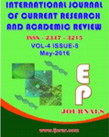Abstract Volume:4 Issue-5 Year-2016 Original Research Articles
 |
Online ISSN : 2347 - 3215 Issues : 12 per year Publisher : Excellent Publishers Email : editorijcret@gmail.com |
2Service de pediatrie, Centre Hospitalier et Universitaire de Brazzaville, Congo
3Service de Pneumologie (Service du Pr KAYEMBE), Cliniques Universitaires de Kinshasa, Kinshasa, Republique Democratique du Congo
4Professeur Emerite de Pediatrie, Faculte des Sciences de la Sante, Universite Marien Ngouabi, Brazzaville (Congo)
No local spirometric standards exist in Congo (Brazzaville), usable in paediatric pneumology. To determine the values of forced vital capacity, maximal expiratory volume per second and peak expiratory flow in the children and teenagers of the rural and urban areas and to establish spirometric reference equations according to the anthropometric variables. In this longitudinal study, almost 11994 Congolese pupils from 9 to 17 years old were recruited. They were divided into two groups, 6475 subjects living in urban area and 5519 in rural area. The following spirometric parameters were measured: forced vital capacity, maximal expiratory volume per second and peak expiratory flow using a portable spirometer. Partial Least Square regression model was applied to the data to establish the spirometric reference equations. No significant difference was found between the two areas, excluded for the peak expiratory flow. Values of the children resulting from rural area versus those of urban area were at the 9 years age: 0.74 l vs 0.85 l for forced vital capacity, 0.64 l vs 0.74 l for maximal expiratory volume per second, 1.04 l/s vs 1.12 l/s for peak expiratory flow. With the 17 years age, values were 2.50 l vs 2.26 l for forced vital capacity, 1.92 l vs 1.76 l for maximal expiratory volume per second, 2.27 l/s vs 3.0 l/s for peak expiratory flow. Positive correlations were found between each spirometric variable and anthropometric parameters (age, height, weight). The equations of prediction were specific of each variable, according to area and sex. The spirometric data obtained in congolese pupils could constitute a useful tool to follow pulmonary development and to diagnose the potential respiratory disorders in the two areas.
How to cite this article:
Bazaba Kayilou Jean Michel, Moussouami Simplice Innocent, Massamba Alphonse, M’Pemba loufoua Anne Berthe, Mabiala babela Jean Robert, Packa Tchissambou Bernard, Kayembe ntumba Jean Marie and Senga Prosper. 2016. Spirometric Profile of Congolese Children and Adolescents in Rural and Urban Areas.Int.J.Curr.Res.Aca.Rev. 4(5): 40-50doi: http://dx.doi.org/10.20546/ijcrar.2016.405.006



Quick Navigation
- Print Article
- Full Text PDF
- How to Cite this Article
- on Google
- on Google Scholor
- Citation Alert By Google Scholar
